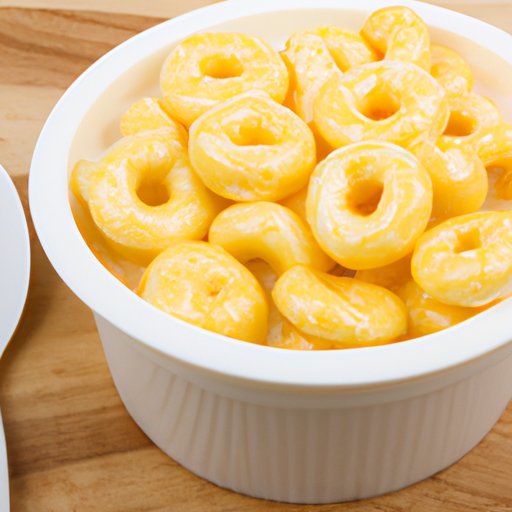
Introduction
Pop-on veneers are an easy, affordable way to enhance your smile and boost your confidence. They are thin, plastic coverings that fit over your teeth and give the appearance of perfect, white teeth. While they are a convenient solution for many people, knowing how to properly care for your veneers is essential to maintaining oral hygiene. This article will explore whether or not you can safely eat with pop-on veneers, the potential benefits and risks, food recommendations, maintenance tips, personal experiences, and address common questions about eating with veneers.
Benefits and Risks of Eating with Veneers
Eating with veneers can be a bit of a daunting prospect, but with some precautions, it can be done safely with minimal risks. The main benefit of eating with veneers is that you can still enjoy all of your favorite foods without feeling self-conscious about your teeth. However, there are risks associated with eating with veneers, including accidentally dislodging or damaging them.
Eating sticky or hard foods can also put extra strain on your veneers or cause them to become dislodged. In addition, highly acidic or sugary foods can lead to erosion or discoloration of the veneers. To prevent these risks and maintain good hygiene, avoid biting or chewing on hard objects, sticky foods, or very hot or cold foods. If you do enjoy these foods, cut them into smaller pieces to avoid putting too much pressure on the veneers.
Food Recommendations
When it comes to eating with veneers, choosing the right foods is essential to protect your dental health. Soft, non-sticky foods that are easy to chew and swallow are generally the safest option for veneers. Some good options include cooked vegetables, soft fruits, mashed potatoes, tender meats, and fish. Avoid eating hard candy, chewing gum, or crunchy foods like nuts as these can damage your veneers or cause them to become loose.
It’s also best to avoid very hot or cold foods as large temperature changes may cause damage to the veneers or discomfort to your sensitive teeth. Drinking hot or cold beverages with a straw can also help to avoid direct contact with your veneers.
When it comes to meal suggestions, try mashed sweet potato with grilled salmon, roasted chicken with cooked green beans, or quinoa stir-fry with tofu and mixed vegetables. These meal options are both healthy for your body and gentle on your veneers.
Maintenance Tips
To keep your veneers looking and feeling their best, consistent maintenance is key. Regular brushing and flossing can help to prevent the buildup of plaque and bacteria, which can lead to tooth decay or gum disease. Brush your teeth twice a day with a soft-bristled toothbrush and non-abrasive toothpaste, making sure to clean around the veneers. Flossing at least once a day can also help to keep your teeth and gums healthy and prevent plaque buildup from turning into tartar.
If you notice any food particles lodged between your veneers and natural teeth, use a water flosser or interdental brush to gently remove them. Avoid using metal tools or toothpicks as these can scratch or damage the veneers. Additionally, regular dental check-ups are essential to monitor the health of your veneers and catch any potential issues before they become larger problems.
Personal Experiences
Eating with veneers is a unique experience for everyone. Depending on the shape and placement of your veneers, you may find certain foods more difficult to eat than others. Mallory, a 32-year-old woman from California, got pop-on veneers last year and has had her fair share of trial and error when it comes to eating with them. “I find that biting into hard foods, like an apple, can be tricky. I usually cut it into small pieces so I don’t risk damaging my veneers,” she says. “When I first got my veneers, I was nervous to eat in public, but now I realize that it’s all about taking your time and being mindful of what you’re eating.”
Q&A Style
Q: Can I eat chips with veneers?
A: While it’s best to avoid problematic foods like hard candy, chewing gum, and crunchy foods, chips can be eaten by being mindful. Try breaking the chip into smaller pieces and chew slowly with your back teeth instead of biting down on them.
Q: Can I drink alcohol with veneers?
A: Yes, you can drink alcohol with veneers, but in moderation. Excessive and repeated alcohol consumption will damage the veneers in the long run. Remember to drink plenty of water to stay hydrated and avoid alcohol swishing by using a straw to avoid direct contact with your veneers.
Q: Can I smoke with veneers?
A: It’s not recommended to smoke with veneers, as this can cause discoloration or damage to the veneers. Smoking can also stain your teeth or lead to gum disease, increasing the risk of complications with your veneers in the future.
Conclusion
While eating with pop-on veneers can pose some challenges and risks, with some careful planning and mindful habits, you can still enjoy your favorite foods while maintaining healthy veneers. Remember to choose soft, non-sticky foods and cut larger items into smaller pieces to avoid undue pressure on the veneers. Regular maintenance and dental check-ups are important to keep your veneers looking and feeling their best, and personal experiences and Q&A style questions can provide useful insights and advice for navigating eating with veneers.




